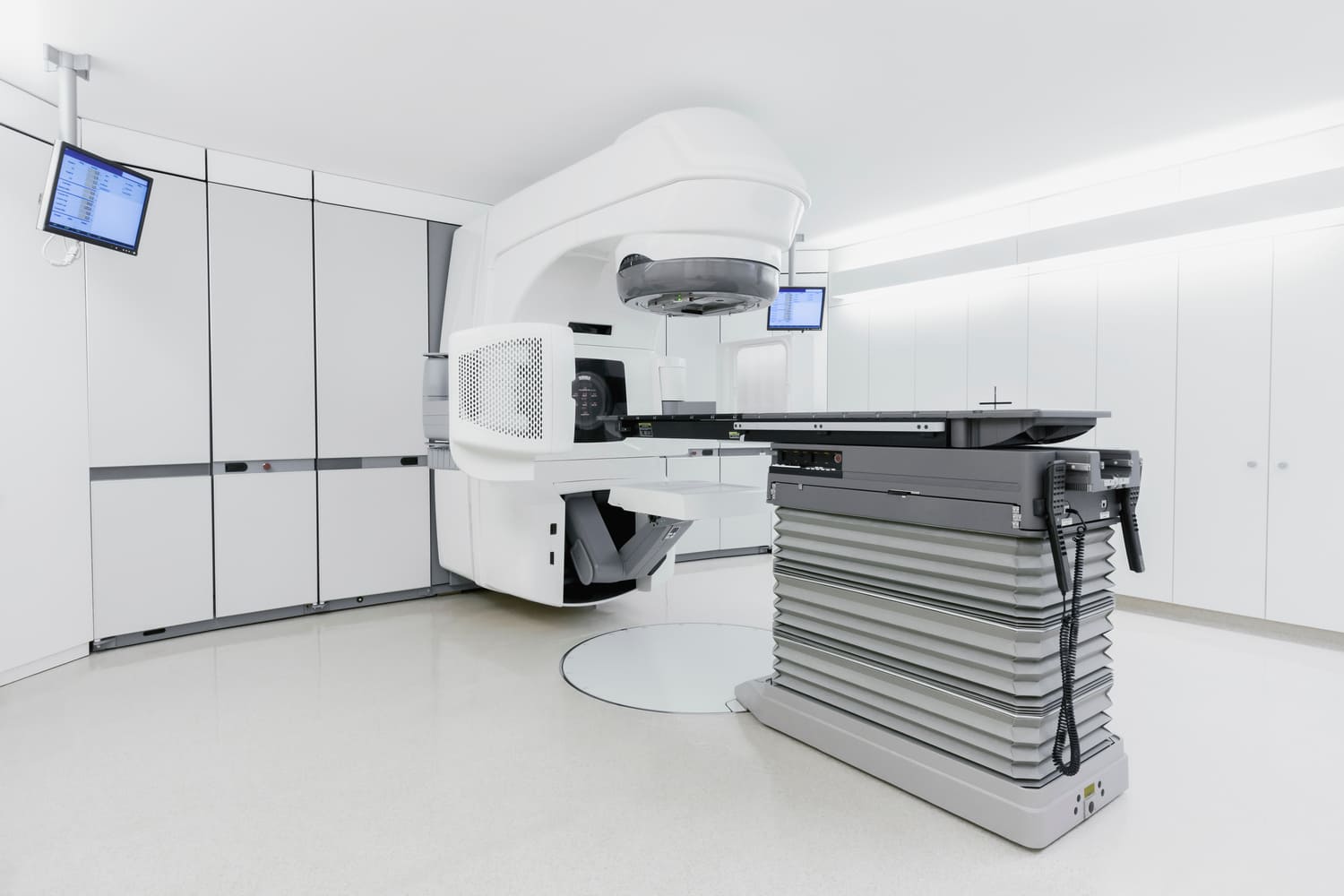
Lung Cancer
At WEGE Klinik, we treat lung cancer with a clear focus: delivering precise, personalised radiotherapy that adapts to each patient’s needs and clinical situation. Our approach relies on cutting-edge technology, careful planning, and close collaboration with referring specialists.
Patients are usually referred after diagnostic work-up and tumour board discussion, often by their respiratory physician or oncologist. During the first consultation, we carefully review all medical reports and imaging to assess the best radiotherapy strategy. Timing, method, and expected side effects are discussed in detail to support informed decisions.
Our treatments are guided by innovation and delivered with deeply human care. Experience precision medicine in a place where you are truly seen and supported.
*Mandatory fields
Specialists in lung cancer care
Led by Prof. Dr. Michael Pinkawa, our radiotherapy team has extensive experience in treating lung tumours. Radiotherapy at WEGE is carried out by an interdisciplinary team, combining technical expertise with a patient-centred approach.
Meet our team
Treatments at WEGE
At WEGE, we are highly specialised in the treatment of lung cancer using state-of-the-art radiotherapy techniques. Our centre combines advanced technology with clinical expertise to deliver personalised care with maximum precision. Each treatment is planned and executed by a multidisciplinary team to ensure safety, accuracy, and effectiveness, even in complex cases.
We offer several radiotherapy approaches depending on the type, size, and location of the tumour. Our goal is to achieve the best possible tumour control while preserving healthy lung tissue and minimising side effects.
External beam radiotherapy (EBRT)
External beam radiotherapy (EBRT) in lung cancer is the most frequently applied radiotherapy technique

External beam radiotherapy (EBRT) in lung cancer is the most frequently applied radiotherapy technique. In small cell lung cancer, an operation has no relevant role in treatment concepts. In non-small cell lung cancer, an operation is the preferred method in smaller peripheral tumours or tumours with limited lymph node involvement.
EBRT is applied either postoperatively in cases of positive resection margins or extensive mediastinal tumour, or more commonly as a primary treatment of the lung cancer and the involved mediastinal lymph nodes. In the curative setting, EBRT is delivered in 30–33 fractions, five sessions per week, lasting overall 6–7 weeks.
EBRT, usually in combination with systemic treatment such as chemotherapy and immunotherapy, is the standard curative method in lung cancers without distant metastases. It is potentially curative in patients with so-called oligometastatic cancers (up to three metastases that are treated with stereotactic radiotherapy). Furthermore, EBRT is used to alleviate symptoms of larger tumours, predominantly breathing difficulties, swallowing problems or pain.
In small cell lung cancer, prophylactic cranial irradiation is often recommended after successful treatment of the primary lung cancer, as this cancer type is frequently associated with brain metastases. Prophylactic cranial irradiation can prevent the development of brain metastases according to various studies, eliminating cancer cells not yet visible on MRI. Cranial irradiation is usually applied in 15 fractions, five sessions per week over a period of 3 weeks.
IMRT with VMAT – advanced precision radiotherapy techniques
For patients with centrally located or locally advanced lung tumours, WEGE Klinik uses intensity-modulated radiotherapy (IMRT). This technique allows the radiation dose to be shaped precisely around the tumour while reducing exposure to nearby healthy tissues such as the heart, spinal cord, and oesophagus. It is especially useful when the tumour is close to sensitive structures, offering effective tumour control with fewer side effects.
VMAT is currently the preferred specific IMRT technique. This method delivers radiation continuously as the machine rotates around the patient, allowing for shorter treatment sessions and highly conformal dose distribution. VMAT is particularly efficient for treating wide or irregular target areas while sparing healthy lung tissue.
Stereotactic body radiotherapy (SBRT)
SBRT is a very effective local radiotherapy method that focuses extremely high doses on specific tumours in a few treatment fractions

SBRT is a very effective local radiotherapy method that focuses extremely high doses on specific tumours in a few treatment fractions. Tumour cell survival is not possible within the high-dose region (ablative dose). Fibrous tissue replaces the tumour in this high-dose region during the follow-up period. Regular CT imaging is performed after treatment to monitor this process and to exclude the development of locoregional recurrences.
SBRT is the first-line treatment in functionally inoperable patients with smaller peripheral tumours (non-small cell lung cancer) or patients refusing surgery. An FDG PET/CT (fluorodeoxyglucose positron emission tomography combined with a computed tomography) scan is usually performed before treatment to exclude tumour spread outside the primary site. PET imaging uses specific metabolic tumour characteristics to detect even small tumour areas in the body.
Each treatment is carefully planned to account for tumour movement during breathing. Radiation is delivered only when the tumour is in the correct position, enhancing both safety and effectiveness
What is lung cancer? |
Anatomy and function of the lungs |
How lung cancer develops |
Symptoms and risk factors |
|---|---|---|---|
|
Lung cancer is a disease in which abnormal cells grow uncontrollably in the lung tissue. These cells form a tumour that can interfere with breathing and may spread to other parts of the body.
Most lung cancers begin in the lining of the airways, and early detection increases the chances of successful treatment. |
The lungs are two sponge-like organs in the chest. They supply the body with oxygen and remove carbon dioxide. Each lung is divided into lobes—three on the right, two on the left.
Air enters through the trachea, passes through the bronchi, and reaches smaller airways called bronchioles and alveoli, where gas exchange occurs. The lungs work closely with the heart and blood vessels to maintain essential body functions. |
Lung cancer starts when mutations in lung cells cause uncontrolled growth. These cells can form a localised tumour, which may invade nearby structures or spread through the lymphatic system or bloodstream.
Some tumours grow slowly; others are more aggressive. Treatment planning depends on tumour type, location, and how it behaves.
|
Lung cancer may not cause symptoms in early stages. As it progresses, common symptoms may include:
Risk factors include smoking (active or passive), exposure to radon or asbestos, air pollution, family history of lung cancer, and previous radiation therapy to the chest. |
It can be curable if diagnosed early. In more advanced stages, treatment helps slow the disease and manage symptoms.
Yes. Around 10–20% of lung cancer cases occur in non-smokers.
Treatment depends on the type and stage of the disease. At WEGE Klinik, options include high-precision radiotherapy, stereotactic body radiotherapy (SBRT), and in selected cases, brachytherapy.
No. Radiotherapy is painless during the session. Some fatigue or mild side effects may appear over time, but the procedure itself does not hurt.
Many patients continue their normal activities with some adjustments. It’s important to listen to your body and ask for support if needed.
Testimonials
At WEGE, we are committed to supporting our patients and their families throughout the lung cancer journey, offering expert care and understanding every step of the way.
 Volker, 72 – Aachen, Germany
Volker, 72 – Aachen, Germany
“The level of care from Dr. Pinkawa’s team was exceptional. They took the time to understand my situation and adapted the treatment to suit my needs. I appreciated their honesty, precision, and empathy. You can tell they’re experts, but they also listen — and that made all the difference.”
 Rainer S., 67 – Bonn, Germany
Rainer S., 67 – Bonn, Germany
“I was told surgery wasn’t an option for me, so radiotherapy became my best chance. At first, I was afraid it wouldn’t be enough — that I’d just run out of options. But from the first day at WEGE Klinik, I felt I was in the right place. The calm way they explained everything, the attention to detail, and the respect they showed me — it all helped me stay strong. I came for treatment, but what I found was hope.”
 Clara, 61 – Mainz, Germany
Clara, 61 – Mainz, Germany
“You have to trust the medical teams — they truly cared about making me feel comfortable at every step. I can only thank them for the exceptional attention and support they gave me.”
If you have general questions, you can contact us by phone or e-mail. We will then get in touch with you as soon as possible.
WEGE Klinik:
Phone: +49 228 5306 0
Email: info@wegeklinik.com
Web: www.wegeklinik.com
WEGE MVZ:
Phone: +49 228 5306 202
Email: info@wegemvz.com
Web: www.wegemvz.com